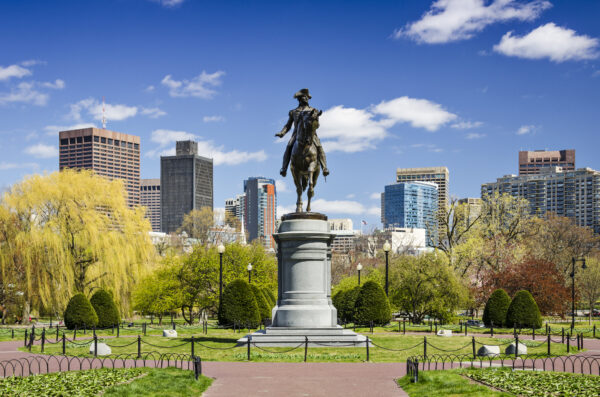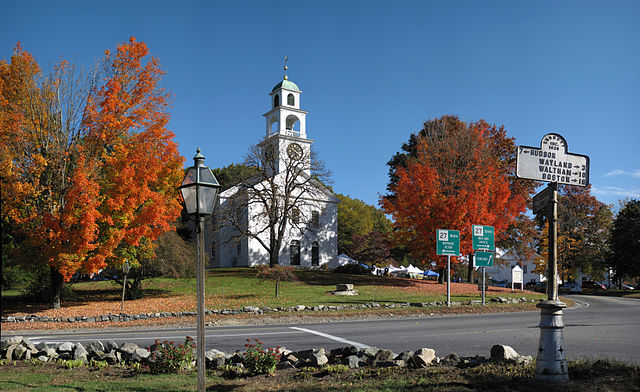By Grayce Rose, recent graduate of the Farm and Food Systems program at Greenfield Community College and NOFA/Mass Intern.
Amidst the modern functions of life in present day Massachusetts, there are symbolic structural and cultural links to serious inequities present in the state’s history. Historical landmarks dot the commonwealth, from antique dwellings, monuments, and gravesites, to spaces where historical actions molded current realities. Integral to much of the state’s history and resulting governance, is the concept of the commons.

Equestrian statue of George Washington (Boston)
Nearly all towns in Massachusetts are marked by green spaces at the hub of what is, or what once was, the center of community function. A source of great pride for many, these relics and their conservation evoke a lingering sense of the communal effort of European colonists to mold a space to their idealized image, a “city on a hill” centered in piety and community. Yet, these spaces have been entangled in a complex tale of changing identity and function. Land that was seized by Europeans in the name of accessibility, communal production, and sustenance, fell short of its intended use. A culture of Eurocentric, racially-biased, and gendered religious determinism in the early decades of the colony of Massachusetts, set a lasting precedent of exclusivity in regards to common land.
An exploration of the concept of common land in a European culture of individualism and private enterprise, as was the case in colonial Massachusetts, could start long before Europeans set foot in New England, with the Magna Carta, and the associated Charter of the Forest, in 1225. In this document, which marked a foundational turning point in European legislation, there was specific language regarding the allotment of land to be used for communal sustenance. Hunting, fishing, grazing, and other forms of acquiring food were permitted in designated spaces that were to be converted from privatized land holdings, which restored a function that was vital to many of those who were disenfranchised by the prevailing class system in England. This practice was held and intensified in the protestant ethic of the first European colonists in Massachusetts. Though centuries had passed since the evocation of the Charter of the Forest by the time the first colonists arrived in Massachusetts in the seventeenth century, this tradition of publicly allotted space for various functions of common sustenance, aligned with the puritanical concept of a self-regulating and cohesive community that was juxtaposed with their valuation of expressing piety through individual labor (1).
Working both individually and as a religiously-bound communal unit was a cornerstone of puritanical society in colonial Massachusetts. The range of puritan influence in the infancy of the colony was initially culturally implicit in the freedoms regarding governmental structure in the Massachusetts Bay Colony Charter of 1629, given the religious focus of those that initially colonized Massachusetts. The colony had been chartered under the assumption of England gaining profit through the installation of industries, such as lumber and fishing, within the colony. A strict outline for how to carry out governance was not included in the charter, and thus opened the door for the religiously centered colonists to govern on the basis of their religious beliefs, which were largely discriminatory in nature (2).

First Parish Meetinghouse, Sudbury, MA. Photo credit: Jan C. Hardenbergh
The small size of settlements centered around religious institutions supported this theocratic structure. Congregational meetinghouses were the focal points in town design, with a green of common community use preceding it. Aside from this green, which found function as a place for social meetings, militia training, and space utilized in a grazing rotation for livestock, in the early years of the colony much of the waterfront space was also designated for public access for fishing, and forested areas for hunting. A lax system of divvying seized land between colonizers who were male heads of households served to make their access to lands for personal use a right for only certain individuals (3).
The fact that all of the land in question was stolen from Indigenous peoples made its designation as public a pure fallacy, and the legal justifications made by colonizers to do so have had a devastating impact that has evolved and remained to the present day. A foundational document in which European colonizers made mention of a legal obligation to designate common land was in the Massachusetts Body of Liberties of 1641. In this statute, land was to be made publicly available to citizens for cultivation, hunting, and fishing. In this same document, compulsory labor in the form of slavery was legalized in the colony, primarily upon a basis of race. Indigenous peoples, and later individuals who were trafficked through the trans Atlantic slave trade, would be forced into labor, and barred from accessing common land for their own sustenance and other pursuits at their own digression (4).
The Massachusetts Body of Liberties of 1641 intermingled church and state and was imbued with a sense of religious determinism, that is, that those who stole the land were the chosen of God. The legal and social implications of this document would serve to spark further stratification of people living in the colonized space of Massachusetts. Later, more aggressive actions and policies of this kind would continue and compound, and in regards to common space, the following centuries would see an evolution of both the amount of common spaces, as well as the use of existing ones, that would further the extent of the fierce inequity of land accessibility in Massachusetts.
In future articles there will be an exploration of the policies surrounding and exacerbating these inequities, specifically the shift from outright religious determinism in government, to racially and economically discriminatory policies and practices that would bar individuals from use of common space.

Grayce Rose, recent graduate of the Farm and Food Systems program at Greenfield Community College and NOFA/Mass Intern. Photo credit Grayce Rose.
About the author: Grayce Rose is a recent graduate of the Farm and Food Systems program at Greenfield Community College. She is currently concluding an internship with NOFA where she contributed to research on the history of agricultural policy in Massachusetts.
References:
1. Caperchi, G. (2013, May 14). America’s Most Enduring Common Ground. The Genealogy of Consent. Retrieved from https://thegocblog.com/category/commons/page/2/
2. Konig, David Thomas. “Community Custom and the Common Law: Social Change and the Development of Land Law in Seventeenth-Century Massachusetts.” The American Journal of Legal History, vol. 18, no. 2, 1974, p. 137., https://doi.org/10.2307/844964.
3. Black, Barbara A., and David T. Konig. “Community and Law in Seventeenth-Century Massachusetts.” The Yale Law Journal, vol. 90, no. 1, 1980, p. 232., https://doi.org/10.2307/795863.
4. Gray, Francis Calley. Remarks on the Early Laws of Massachusetts Bay: With the Code Adopted in the Year 1641, and Called The Body of Liberties, Now First Printed. Charles C. Little and James Brown., 1843.





